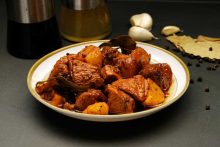 Discover and savor the rich flavors of Filipino cuisine, where every dish tells a story of cultural heritage and innovation. Expect fresh seafood delights to bountiful tropical flavors, the Filipino cuisine offers an array of dishes that will satisfy even the most discerning palate.
Discover and savor the rich flavors of Filipino cuisine, where every dish tells a story of cultural heritage and innovation. Expect fresh seafood delights to bountiful tropical flavors, the Filipino cuisine offers an array of dishes that will satisfy even the most discerning palate.
The culinary landscape of the Philippines reflects diverse influences, shaped by its vibrant history. At the heart of Filipino cuisine is its ability to blend diverse flavors into harmonious culinary masterpieces. Think of contrasting tastes and textures served on a plate. Generations have passed down culinary traditions, resulting in the unique flavors found in authentic Filipino dishes that we enjoy today such as the hearty comfort of sinigang, the zesty tang of adobo, or the aromatic richness of the kare-kare.
With over 7,000 islands, each region of the Philippines boasts its own culinary specialties, reflecting the unique ingredients and cultural influences of the area. In the northern region of Ilocos, diners indulge in the tangy flavors of pinakbet (mixed vegetable stew). In the Visayas, seafood takes center stage, with dishes like kinilaw (ceviche) and lechon (roast pig) drawing crowds of eager food enthusiasts. Meanwhile, in Mindanao, dishes like piyanggang (grilled chicken in coconut milk) and tiyula itum (black soup – braised beef or goat) showcase the region’s rich Muslim heritage.
The country’s coastline treasures should not be missed. Delight in the freshness of grilled fish, succulent prawns, and mouthwatering squid dishes, each prepared with local herbs and spices to enhance their natural flavors. With the country’s numerous fishing communities and coastal towns, seafood is often caught and served on the same day, ensuring optimal flavor and quality. In Batangas, feast on tawilis, a type of freshwater sardine found only in Taal Lake, while in Cebu, savor the smoky flavors of grilled pusit (squid). Meanwhile, in Bicol, indulge in the fiery goodness of laing, a spicy dish made with taro leaves and coconut milk, often paired with shrimp or crab.
As we delve into fresh food, experience the vibrant palette of tropical fruits and vegetables that define Filipino cuisine. From the sweet tanginess of ripe mangoes to the creamy richness of coconut, tropical flavors infuse every dish with a burst of freshness and vitality. Indulge in refreshing salads, exotic fruit shakes, and decadent desserts that showcase the abundance of nature’s bounty in the Philippines.
No culinary journey through the Philippines is complete without sampling its vibrant street food scene. From bustling markets to roadside stalls, vendors serve an array of snacks and bites that will tickle the curious, the adventurous, or simply the hungry. Sink your teeth into savory skewers of grilled barbecue, savor the crispy goodness of lumpia (spring rolls), or indulge in the sweet decadence of turon (banana fritters). Street food is not just a meal but a cultural experience, offering a glimpse into the everyday lives of Filipinos.
The Filipinos take pride in eating well, from the to the, considering it not just sustenance but also a form of socializing and bonding with friends, family, and guests. Combined with the warm, joyful, and famous Filipino hospitality, every gathering, occasion, and opportunity to taste a delicious dish during your visit to the country becomes a treat not only for your taste buds but also for your spirit.
 Tourism Breaking News
Tourism Breaking News


